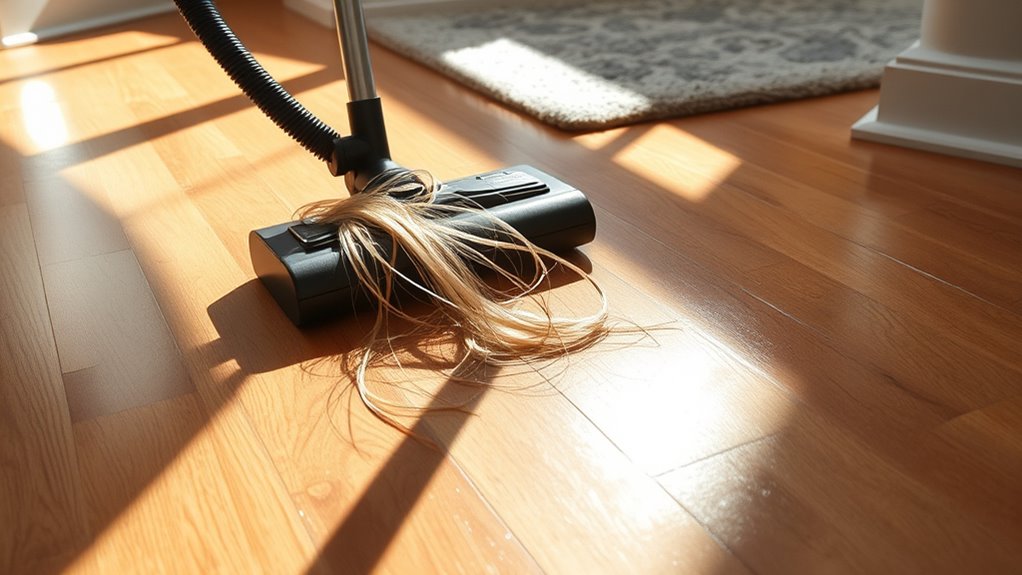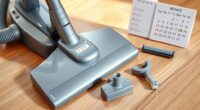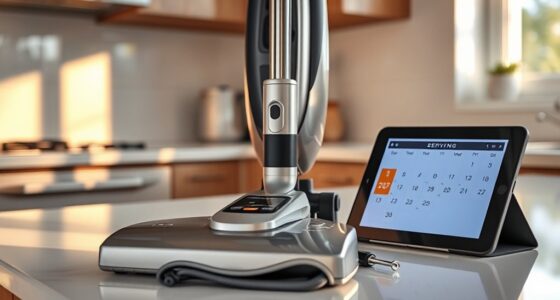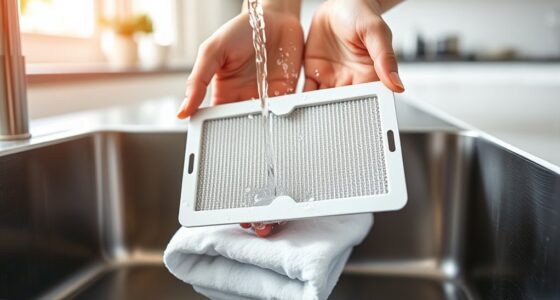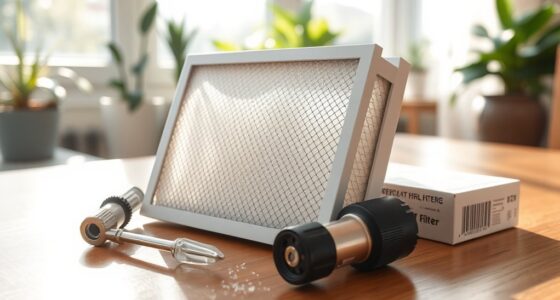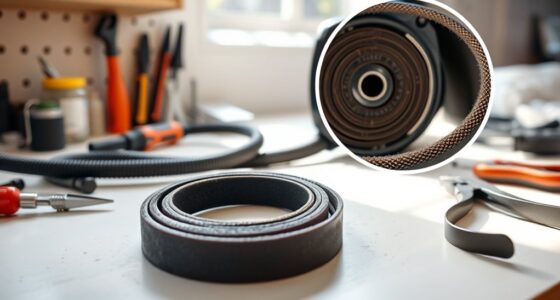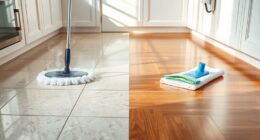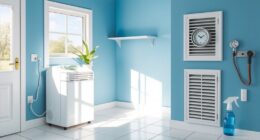To protect your floors, avoid common vacuuming mistakes. Always empty the bag or bin regularly and maintain your vacuum with clean filters. Don’t forget to dust before vacuuming and take your time to avoid rushing the process. Use the correct attachments for different surfaces and vacuum in every direction. Move furniture to reach hidden dust and debris. Finally, be cautious when cleaning hard floors with upright vacuums. For more tips, keep exploring!
Key Takeaways
- Always use the correct attachment for your flooring type to prevent scratches and ensure effective dirt removal.
- Regularly check and maintain the vacuum’s brush roll to avoid scattering debris on hard floors.
- Dust surfaces before vacuuming to minimize airborne particles and improve cleaning efficiency.
- Move furniture to access hidden areas, preventing dirt buildup and ensuring a thorough clean.
- Avoid rushing the vacuuming process; take your time to enhance dirt removal and protect flooring integrity.
Neglecting to Empty the Bag or Bin Regularly

When you neglect to empty your vacuum’s bag or bin regularly, you’re setting yourself up for frustration and ineffective cleaning.
Experts recommend doing this when the vacuum bag is two-thirds full to maintain peak suction power. Waiting until it’s full reduces airflow, causing your vacuum to work harder and potentially shortening its lifespan.
A full bag or bin means less effectiveness in picking up dirt and debris, making your efforts counterproductive. By neglecting to empty it, you risk premature wear on the motor and other components, leading to costly repairs.
Establishing a routine for regular cleaning not only helps maintain efficiency but also guarantees your vacuum performs at its best, leaving your floors spotless and saving you stress in the long run. Regularly emptying the bag or bin can enhance filtration efficiency, ensuring a cleaner environment and better air quality.
Ignoring Maintenance of Your Vacuum Cleaner
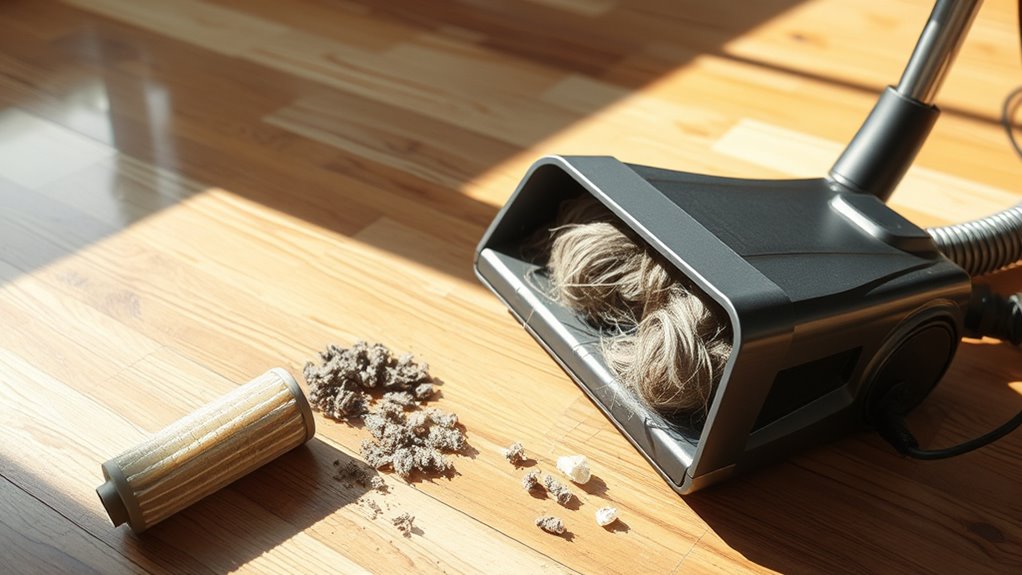
Ignoring the maintenance of your vacuum cleaner can lead to serious performance issues.
Regularly cleaning or replacing filters, along with inspecting belts and brushes, keeps your vacuum running smoothly and effectively.
Don’t wait until your vacuum struggles—stay proactive to guarantee a cleaner home.
Regular Filter Cleaning
Although it might seem like a hassle, regularly cleaning or replacing your vacuum’s filters is crucial for maintaining peak performance. A dirty or clogged filter can reduce suction power and compromise your cleaning efforts, causing dust to blow back into the air and harming indoor air quality. This is particularly important because clean homes contribute significantly to reducing allergens and pollutants. To guarantee your vacuum runs efficiently, check and clean the filters at least once a month, especially in homes with pets or high dust levels. Regular maintenance of your vacuum is essential to ensure optimal suction power and cleaning modes for effective cleaning. Additionally, using a vacuum with HEPA filters can further enhance your home’s air quality by trapping allergens effectively. Furthermore, maintaining your vacuum can also indirectly support energy efficiency in your home by ensuring it operates effectively without unnecessary energy consumption.
| Action | Frequency | Effect on Performance |
|---|---|---|
| Clean Filters | Monthly or More | Maintains suction power |
| Replace Filters | Every 6-12 Months | Extends vacuum lifespan |
| Inspect Self-Clean | Monthly | Guarantees effectiveness |
Don’t neglect this crucial maintenance step!
Inspect Belts and Brushes
Neglecting to inspect your vacuum’s belts and brushes can lead to a host of cleaning issues and even damage your flooring.
Regular maintenance is essential to guarantee your vacuum operates effectively without causing harm. Here’s what you should focus on:
- Check for wear and tear: Worn brushes can scratch your floors, while frayed belts reduce suction power.
- Clean accumulated debris: Hair and dirt can clog brushes, diminishing their effectiveness and potentially causing scuff marks.
- Follow manufacturer recommendations: Cleaning or replacing belts and brushes as suggested helps maintain peak performance.
Forgetting to Dust Before Vacuuming
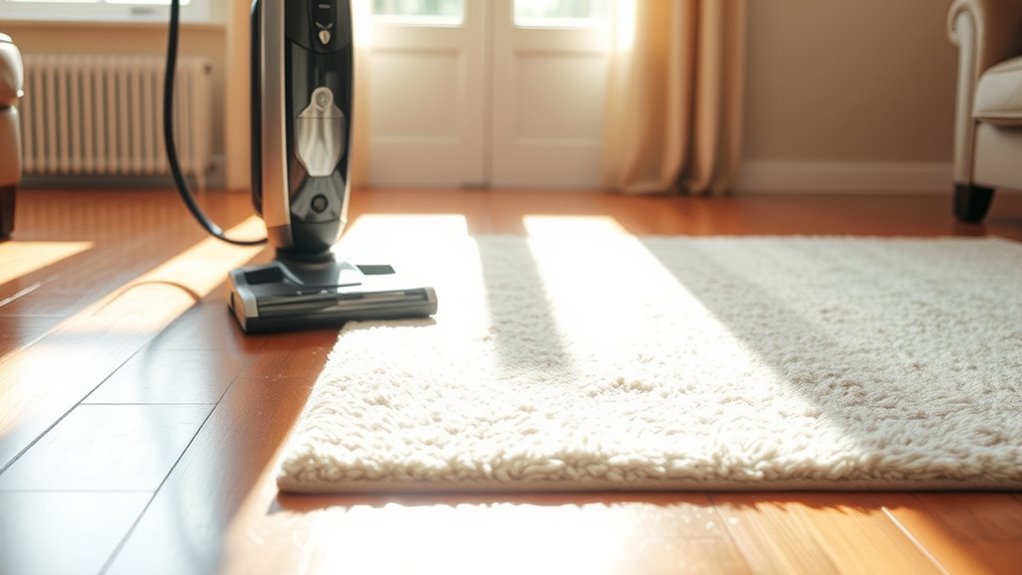
When you forget to dust before vacuuming, you miss an essential step in your cleaning routine that can lead to less effective results. Dusting first allows dislodged particles to fall to the ground, making vacuuming more efficient at capturing dirt and debris. This proper sequence not only saves time by reducing the need for multiple cleanings but also improves your indoor air quality by minimizing airborne particles. Establishing a routine of dusting first contributes to a cleaner and healthier home environment.
| Step | Importance |
|---|---|
| Dusting | Removes airborne dust |
| Vacuuming | Captures dirt/debris |
| Order | Enhances cleaning |
| Efficiency | Saves time |
| Healthier Home | Improves air quality |
Rushing the Vacuuming Process

Rushing through vacuuming can leave behind dirt and allergens, harming your indoor air quality.
By taking the time to inspect the area for larger items and slowing down your technique, you’ll guarantee a deeper clean and protect your vacuum from damage.
A bit of patience goes a long way in making your cleaning more effective.
Inspect Area First
Before you start vacuuming, it’s essential to take a moment to inspect the area for large debris. This quick check can prevent vacuuming mistakes that could lead to potential damage.
By taking the time to survey the space, you enhance your overall cleaning effectiveness while avoiding unnecessary repairs.
Consider these points:
- Remove coins, toys, or other large objects that can clog your vacuum.
- Ascertain airflow isn’t obstructed, which could reduce suction power.
- Clear away dust and debris that might hinder the cleaning process.
- Ensuring you don’t overlook the type of system can help you choose the right vacuum for your flooring needs.
Slow Vacuuming Technique
Although it may be tempting to speed through vacuuming to save time, doing so can lead to missed debris and less effective cleaning. By adopting a slow vacuuming technique, you enhance dirt and dust removal, improving your indoor air quality. Common mistakes people make include rushing, which disrupts airflow and reduces suction, leaving dirt behind in carpet fibers.
| Mistake | Impact on Cleaning | Solution |
|---|---|---|
| Rushing the process | Missed debris | Slow down |
| Ignoring airflow | Reduced suction | Guarantee your vacuum’s efficiency |
| Neglecting filters | Poor performance | Clean or replace filters |
| Skipping regular sessions | Increased cleaning time | Schedule regular vacuuming |
| Overlooking agitation | Ineffective dirt removal | Focus on slower movements |
Taking your time makes vacuuming more effective and less of a chore.
Not Using the Correct Attachment
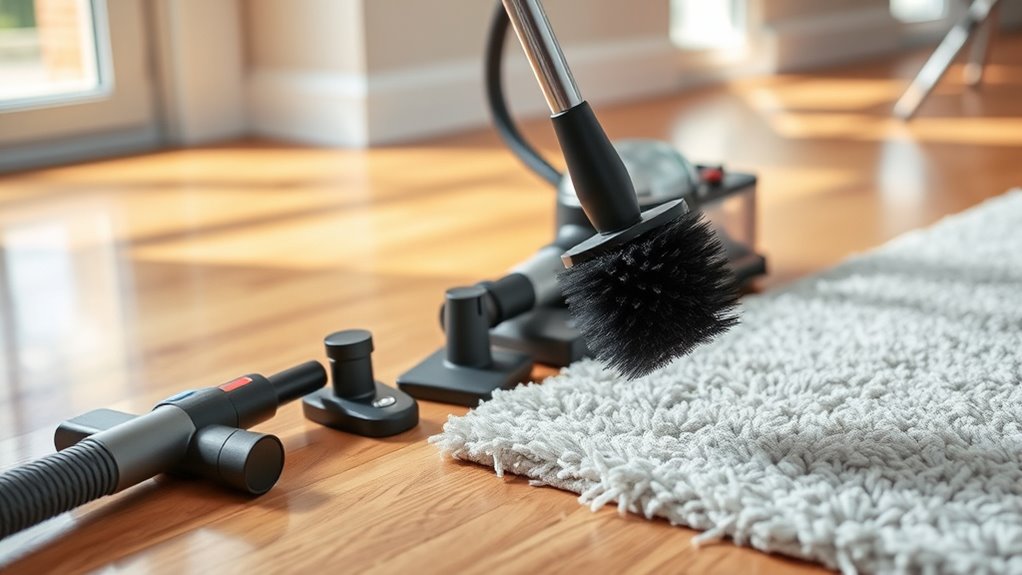
Using the wrong vacuum attachment can really throw a wrench in your cleaning routine. Not using the correct attachment can lead to scratches on hard floors and leave dirt behind, ultimately reducing your cleaning efficiency.
Using the wrong vacuum attachment can hinder your cleaning, causing scratches and leaving dirt behind. Choose wisely for better efficiency.
Each attachment has a specific role, and using the wrong one can scatter debris instead of picking it up.
- A bristle brush is great for carpets but can damage hard surfaces.
- Specialized attachments, like crevice tools, help you reach tight spots.
- Always check your vacuum’s manual for the right attachments for different surfaces.
Not Vacuuming in Every Direction

Choosing the right vacuum attachment is just the start of effective cleaning. If you’re not vacuuming in every direction, you’re likely leaving dirt and debris trapped deep within your carpet fibers.
To boost your cleaning efficiency, make certain to vacuum front to back, side to side, and even diagonally. This method agitates the carpet fibers, dislodging hidden dust and allergens that might otherwise go unnoticed.
A thorough vacuuming approach guarantees that no debris is left behind, leading to a cleaner home environment. Studies show that this extensive technique improves indoor air quality considerably by reducing dust accumulation.
Not Moving Furniture Before Vacuuming
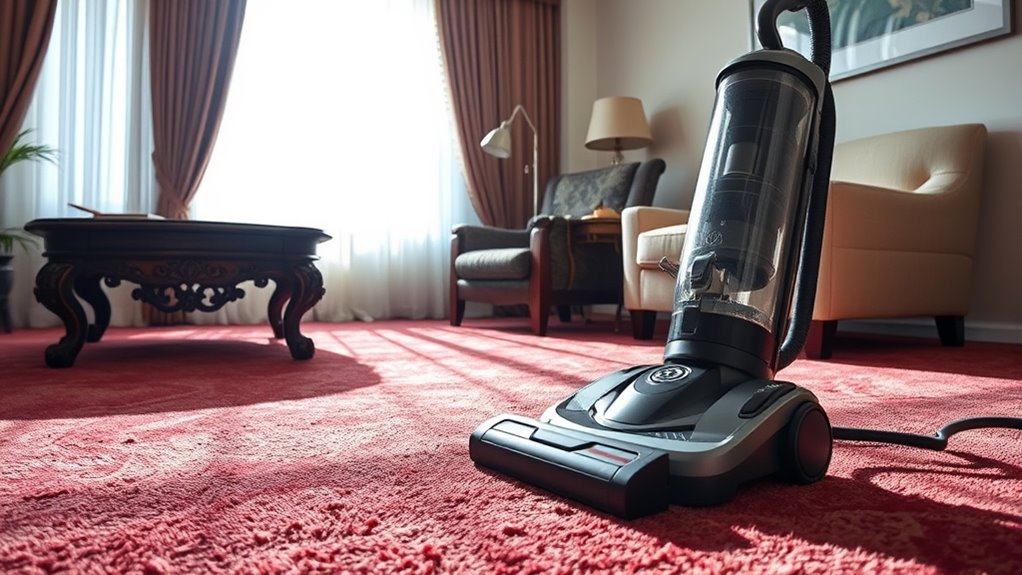
If you want a truly clean home, don’t forget to move your furniture before vacuuming.
Not moving furniture is a common vacuuming mistake that can leave hidden dust and dirt trapped beneath, reducing your cleaning effectiveness.
To achieve a thorough clean, make it a habit to:
- Access areas where dust and debris accumulate.
- Prevent grime buildup that could require intensive cleaning later.
- Maintain your flooring’s integrity by avoiding wear and tear.
Underestimating the Impact of Pet Hair and Floor Debris
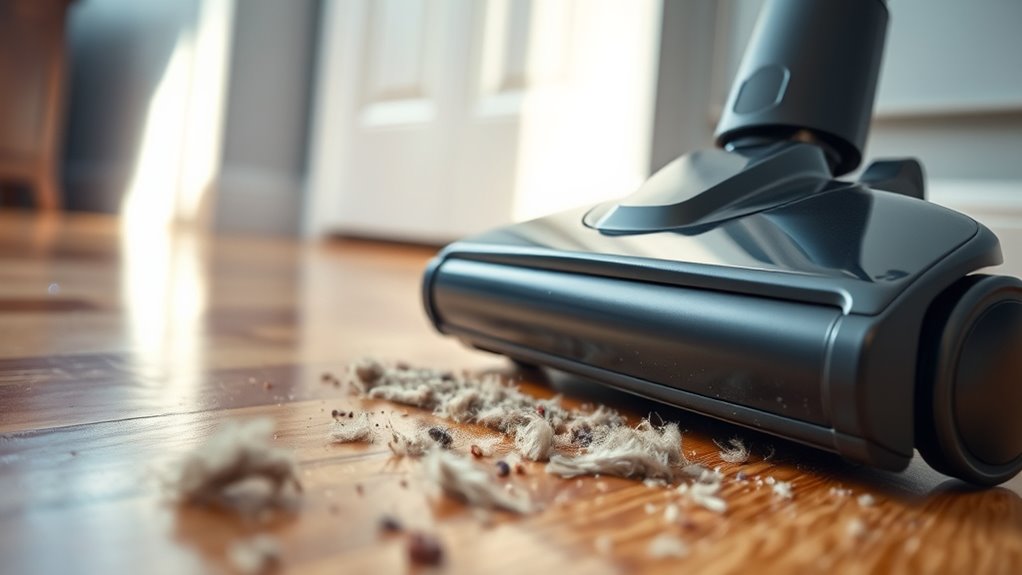
Neglecting to account for pet hair and floor debris can seriously undermine your vacuuming efforts. Pet hair can quickly clog your vacuum system, reducing suction and potentially damaging the motor.
Likewise, ignoring larger floor debris, like coins, can break belts or cause other internal damage, leading to costly repairs. By regularly removing pet hair and debris, you maintain peak vacuum performance and avoid premature replacements.
High concentrations of pet hair can create hazardous conditions, exacerbating allergens and respiratory issues if left unchecked. Regular maintenance of your vacuum cleaner is essential for ensuring it operates efficiently and prolonging its lifespan.
Don’t let these vacuuming mistakes affect your indoor air quality or overall home cleanliness. Prioritize thorough inspections and frequent cleaning to keep your living space free from dirt and allergens.
Cleaning Hard Floors With an Upright Vacuum
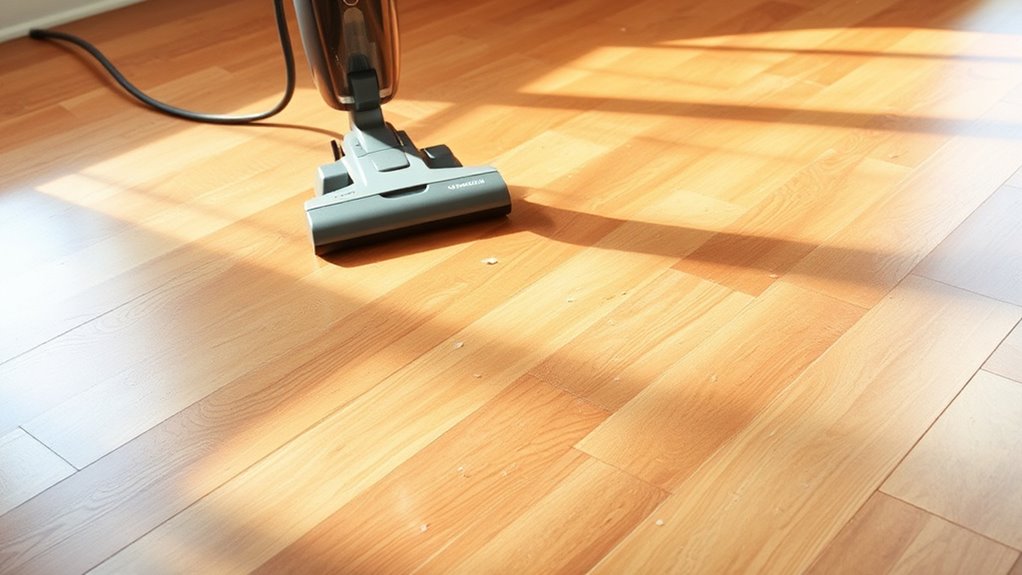
Many homeowners face challenges when cleaning hard floors with an upright vacuum.
These vacuums, often designed for carpets, can scatter debris and dust instead of effectively removing it. If you’re not careful, you could also cause damage to your floors due to scratches.
To avoid these pitfalls, consider the following:
- Use an upright vacuum with a hard floor setting or attachment.
- Regularly check the brush roll for wear to guarantee it’s effective.
- Opt for vacuums specifically designed for hard floors, featuring softer bristles.
Frequently Asked Questions
Is There a Wrong Way to Vacuum?
Yes, there’s definitely a wrong way to vacuum. If you rush through the process, you might miss dirt and debris, leaving your floors less clean.
Using the wrong attachments can scratch surfaces, while failing to move furniture can create hidden dust traps. Not adjusting your vacuum settings for different floor types can lead to damage, and vacuuming over large debris can hurt your vacuum.
Take your time and use the right tools for better results!
Will the Brushes on Vacuum Damage Carpet or Floors?
Imagine you’re vacuuming a beautiful, high-pile carpet with a standard brush. You mightn’t realize that those stiff bristles can cause fraying and wear over time.
Yes, the brushes on your vacuum can definitely damage your carpet or floors if they’re not suited for the surface. For hardwood, using a vacuum with rotating brushes can scatter debris, leaving your space messy.
Will Vacuum Cleaner Damage Hardwood Floors?
Yes, a vacuum cleaner can damage hardwood floors if you’re not careful.
Using a vacuum designed for carpets might scatter debris and scratch the surface. Instead, opt for stick or canister vacuums with soft bristles, which are safer.
Make sure to regularly check and clean the brush roll to prevent hair buildup that could harm your floors.
Always use attachments meant for hard surfaces to maintain your hardwood’s finish and integrity.
What Should You Not Vacuum Up?
You shouldn’t vacuum up large objects like coins or toys, as they can harm your vacuum’s motor.
It’s also essential not to vacuum wet spills; doing so can create electrical hazards.
Avoid sharp items like glass shards, which can puncture bags and lead to expensive repairs.
Fine powders, like flour, can clog filters, and flammable materials, such as lighter fluid, pose serious fire risks.
Stick to vacuuming safe debris for best performance.
Conclusion
To summarize, avoiding these common vacuuming mistakes can help protect your floors and keep them looking great. Are you ready to give your vacuuming routine a makeover? By regularly emptying bags, maintaining your vacuum, and using the right attachments, you’ll guarantee your efforts pay off. Take the time to dust, move furniture, and tackle pet hair effectively—your floors will thank you! With a little care, you can make vacuuming a breeze and extend the life of your floors.
